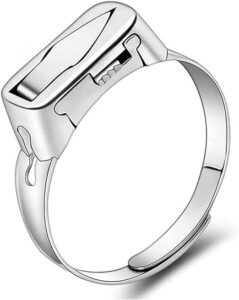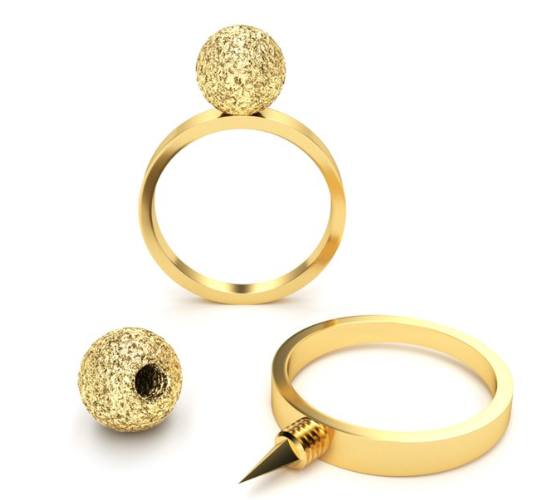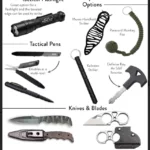Self-defense rings stand the line between fashion and safety, providing unnoticed yet effective protection in different kinds of situations. These little products aim to help people by delivering a feeling of security without losing grace. The primary goal of these rings is to act as covert defensive tools, providing an extra layer of safety in everyday life.
The demand for self-defense rings has recently increased significantly, indicating rising worries about personal safety. These rings appeal to a wide range of people looking for effective and invisible measures of protection. Because of their silent look, they are an attractive alternative for individuals exploring urban environments or performing typical tasks.
Self-defense ring designers are constantly refining their designs, including new materials and practical parts to improve their power. These creative changes ensure that these rings are not only fashionable but also reliable weapons for personal security in an uncertain society.
Does self-defense rings work?
Effectiveness in Personal Protection
The effectiveness of self-defense rings in personal protection is a subject that often raises curiosity and discussion. These discreet accessories, designed with defensive functionalities, aim to offer a sense of security in uncertain situations. While their primary purpose is to empower individuals, the effectiveness of these rings may vary based on factors such as design, material, and user proficiency.
Real-life Situations and Testimonials
Numerous anecdotes and testimonials highlight instances where self-defense rings have proven instrumental in diffusing potentially threatening situations. These accounts underscore the importance of preparedness and the role these rings can play as a deterrent. However, individual experiences may differ, and the effectiveness of these rings can also depend on factors like situational awareness and the assailant’s intentions.
Can a ring be a weapon?
Exploring the Defensive Capabilities
The question of whether a ring can function as a weapon is a subject of debate and consideration. Self-defense rings, while primarily designed for personal protection, can possess defensive capabilities. Their construction often involves durable materials and specialized designs intended to augment defensive functions. However, it’s essential to understand the legal and ethical considerations surrounding their usage as defensive tools.

Legal Considerations and Restrictions
The classification of a ring as a weapon varies across different jurisdictions. While some places may permit the possession and use of self-defense rings as defensive tools, others may classify them as offensive weapons subject to legal restrictions. Understanding the local laws and regulations is crucial to avoiding potential legal consequences.
Read: Pocket Knife for Self-Defense
Features and Advantages of self-defense rings work
When considering the most effective self-defense ring, several key features and advantages stand out across the top models:
- Durability: Most top picks boast robust construction, ensuring longevity and reliability in crucial moments.
- Ease of Carry: The ergonomics of these rings prioritize comfort and ease of carrying, making them suitable for everyday use.
- Defensive Functions: From reinforced striking surfaces to additional safety features, these rings are equipped with functionalities that enhance their defensive capabilities.
Role of Rings in Street Fights
Strategies and Techniques
When considering the role of self-defense rings in street fights, adopting appropriate strategies and techniques is paramount. These tips can significantly impact the effectiveness of utilizing a self-defense ring in such confrontations:
- Awareness and Preparedness: Vigilance and being prepared for potential altercations can help in preemptively utilizing the ring as a defensive tool.
- Proper Grip and Technique: Understanding the optimal grip and striking technique with the ring can maximize its defensive capabilities while minimizing the risk of injury.
- Escape and De-escalation: Using the ring as a deterrent rather than an offensive weapon can assist in de-escalating the situation, allowing for a safer escape.
Safety Concerns: Punching with Rings On
Risks and Precautions
While self-defense rings can provide a layer of protection, punching with rings on requires careful consideration due to the associated risks.
- Potential Injury: Rings can cause abrasions or cuts to the wearer’s hand upon impact, increasing the risk of self-inflicted injuries during aggressive movements.
- Impact on the Opponent: Rings, especially those with protrusions or sharp edges, can exacerbate injuries to the opponent during physical altercations, potentially leading to legal implications.
To mitigate these risks, it’s essential to take certain precautions:
- Proper Fist Formation: Ensuring a closed fist without protruding the ring can reduce the risk of self-injury while maintaining defensive capabilities.
- Awareness of Surroundings: Being mindful of the environment and the potential impact on others when using rings for self-defense is crucial to preventing unnecessary harm.
Recommendations for Safe Usage
Safe usage of self-defense rings revolves around responsible handling and understanding their limitations.
- Training and Practice: Adequate training in self-defense techniques and regular practice sessions can enhance proficiency and reduce the risk of accidents.
- Legal Awareness: Understanding the legal implications of using rings for self-defense in different jurisdictions is crucial to avoid unintended legal consequences.
Adhering to these recommendations can promote safer usage of self-defense rings, minimizing the likelihood of injuries and legal complications.
Understanding Guarded Rings and Knife Rings
Features and Functions
Guarded Rings: Guarded rings are designed with added protective elements, such as raised edges or covering, around the surface. These features serve to shield the wearer’s hand during impact while still allowing for effective defensive manoeuvres. The primary function of guarded rings is to minimize the risk of self-injury while enhancing defensive capabilities.
Knife Rings: Contrarily, knife rings incorporate concealed blades or sharp edges within the design. These rings are primarily intended as offensive tools, featuring elements that can cause harm when used defensively or aggressively. The functionality of knife rings revolves around their potential to inflict injury upon an assailant.
Differences and Suitability
The differences between guarded rings and knife rings lie in their intended purpose and functionality:
- Purpose: Guarded rings prioritize defense and protection, aiming to minimize the risk of self-injury during defensive actions. Conversely, knife rings are designed with offensive capabilities, focusing on the potential to cause harm.
- Suitability: Guarded rings are suitable for individuals seeking defensive aids without the intention of causing harm, offering a balance between protection and safety. Knife rings, on the other hand, are more suited for situations where offensive measures may be required, emphasizing a more aggressive approach to self-defense.
Understanding the distinctions between guarded rings and knife rings is crucial in choosing the most appropriate tool for one’s specific safety needs.
Unveiling the Power Within the Ring
Self-defense rings often carry symbolic significance, portraying a sense of empowerment and personal protection. Wearing such a ring can instill a psychological sense of security, bolstering confidence and preparedness in uncertain situations. The symbolism associated with these rings transcends their physical attributes, serving as a reminder of one’s ability to defend oneself if necessary.
Actual Defensive Capabilities
Beyond their symbolic value, self-defense rings possess tangible defensive capabilities:
- Striking Surface: The construction of these rings, often featuring a reinforced striking surface, allows for effective defensive manoeuvres when needed.
- Deterrent Effect: The mere presence of a self-defense ring can serve as a deterrent, dissuading potential assailants and contributing to personal safety without physical confrontation.
Understanding both the symbolic and practical aspects of self-defense rings empowers users, fostering a sense of preparedness and potential defensive capabilities in unpredictable situations.
Who Can Carry a Self Defense Rings?
Legal Guidelines and Restrictions
The legality of carrying a self-defense ring varies across jurisdictions and is subject to specific regulations:
- Legal Permissibility: In many places, carrying self-defense rings is legal for individuals seeking personal protection. However, certain areas may have restrictions on the size or design of such accessories.
- Restrictions: Some regions might classify specific types of self-defense rings as weapons, imposing limitations on their possession or usage. Understanding local laws and regulations is essential to ensuring compliance and avoiding legal repercussions.
Conclusion
Self-defense rings represent more than just accessories; they embody a mindset of preparedness and empowerment. While their defensive capabilities and symbolic significance are undeniable, responsible usage remains paramount. Incorporating these rings into one’s safety measures can provide an extra layer of protection, but understanding their role as defensive aids rather than offensive weapons is crucial.
In conclusion, self-defense rings serve as valuable tools, offering a balance between fashion and personal security. Embracing them as part of a broader safety strategy can contribute to a heightened sense of confidence and preparedness in unforeseen circumstances.










